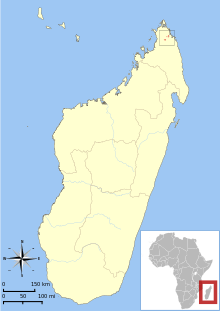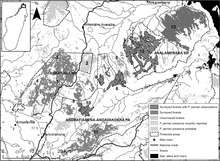Perrier's sifaka
| Perrier's sifaka | |
|---|---|
 | |
| Scientific classification | |
| Kingdom: | Animalia |
| Phylum: | Chordata |
| Clade: | Synapsida |
| Class: | Mammalia |
| Order: | Primates |
| Suborder: | Strepsirrhini |
| Family: | Indriidae |
| Genus: | Propithecus |
| Species: | P. perrieri |
| Binomial name | |
| Propithecus perrieri Lavauden, 1931[3] | |
 | |
| Distribution of P. perrieri[1] | |
Perrier's sifaka (Propithecus perrieri) is a lemur endemic to Madagascar. It was formerly considered to be a subspecies of diademed sifaka[4] It has a very small range in northeastern Madagascar where its habitat is dry deciduous or semi-humid forest. Part of its range is in protected areas. It is an almost entirely black sifaka and measures about 90 cm (35 in), half of which is a bushy tail. Females are slightly larger than males.
It moves in small family groups through the canopy feeding on fruit, leaves, flowers, buds and seeds. Groups have territories of about one hectare and vocalise with each other. The main threats faced by this sifaka are habitat destruction and fragmentation due to slash and burn agriculture, charcoal gathering, and logging. The International Union for Conservation of Nature has rated its conservation status as "critically endangered" and is considered to be one of the 25 most endangered primates in the world.[5]
Description
It has a length of 85 to 92 centimeters, of which 42-46 centimeters are tail.[6] Its pelage is almost entirely black[6] covering everywhere on their body except for their face and ears. They have small, forward-facing eyes. The species have masses ranging from 3.7 to 6.0 kg. They have minimal sexual dimorphism, however females are slightly larger mass on average.[7]
Distribution
Perrier's sifaka has a very limited range in northeastern Madagascar between the Irodo River to the north and the Lokia River to the south.[6] The species' geographic range is concentrated on the Analamerana Special Reserve managed by Madagascar National Parks and in the Andrafiamena Protected Area managed by the NGO Fanamby.[8] Its presence in the Ankarana National Park has been reported a few decades ago but could unfortunately not be confirmed in the last decade.[8]

Its habitat consists of dry deciduous and semi-humid forest.[6] Groups of this species have a home range of about one hectare.
Diet
The diet of Perrier's sifaka resembles that of other sifakas, consisting of fruit, leaves, flowers, buds, petioles, and seeds. Sifakas are naturally suited for this herbivorous diet because they have long gastrointestinal tracts and enlarged cecums.[9] Groups of sifaka do not show any aggression towards other groups when feeding, let alone come into contact with each other.[10] Sifakas in general show seasonal variation in diet. During the wet season, Perrier's sifakas contribute most of their feeding time, about 70 to 90 percent of it, to fruits and seeds, but in the dry season most of the species feeding time is spent on leaves and flowers.[9]
Behavior
Perrier's sifakas use vocalizations to communicate including warning calls and have even been observed to make a sound described as sneezing.[7]
Social Structure
Sifakas have groups between 2 and 6 individuals.[6] Dispersal of sex is unbiased, which is uncommon among most species. Aggression between groups is extremely low as well as the overall encounter rates between groups. Society is largely matriarchal and females have feeding priority.[9] Mating habits have not been thoroughly studied yet.[7]
Life Cycle
The reproductive cycle is bound to the season and sifakas reproduce either every year or every two years. Infants have a slow growth rate given the large abundance of food on Madagascar, but dental development is just the opposite. A hypothesis has been put forth that this is to reduce the dependency period of the offspring and increase the chance of survival for the mother, who does not have to expend energy and time to raise her offspring. Most females do not place much effort into individual offspring, as half of sifaka infants die before the age of one.[9] Infants become independent at the age of two and reach sexual maturity at the age of four for females and at the age of five for males. Males use genital swelling to communicate that they are ready for sex.[7]
Conservation status
Perrier's sifaka is one of the most endangered primates due to the limited distribution and low population density.[8][11] A recent conservation plan for the Perrier's sifaka has been developed following the International Union for Conservation of Nature (IUCN) Species Survival Commission (SSC) Lemur Red List reassessment meeting in Antananarivo in 2012.[12][13] While selective logging still seems to be one of the main threads in Analamerana special reserve, deforestation for slash and burn agriculture and for charcoal production is predominant in Andrafiamena protected area.
References
- 1 2 Andriaholinirina, N.; et al. (2014). "Propithecus perrieri". IUCN Red List of Threatened Species. Version 2014.1. International Union for Conservation of Nature. Retrieved 2014-06-16.
- ↑ "Checklist of CITES Species". CITES. UNEP-WCMC. Retrieved 18 March 2015.
- ↑ Groves, C.P. (2005). Wilson, D.E.; Reeder, D.M., eds. Mammal Species of the World: A Taxonomic and Geographic Reference (3rd ed.). Baltimore: Johns Hopkins University Press. OCLC 62265494. ISBN 0-801-88221-4.
- ↑ Christoph Schwitzer; Olivier Arnoult; Berthe Rakotosamimanana. "An international conservation and research programme for Perrier's sifaka (Propithecus perrieri Lavauden, 1931) in northern Madagascar" (PDF). Lemur News Vol. 11, 2006. Lemur News. Retrieved 24 July 2012.
- ↑ Mittermeire, Russell A; Valladares-Padua, Claudio; Rylands, Anthony B; Eudey, Ardith A; Butynski, Thomas M; Ganzhorn, Jorg U; Kormos, Rebecca; Aguiar, John M; Walker, Sally (2006). "Primates in Peril: The World's Most Endangered Primates, 2004–2006". Primate Conservation. 20: 1–28.
- 1 2 3 4 5 Garbutt, Nick (2007). Mammals of Madagascar, A Complete Guide. pp. 189–191.
- 1 2 3 4 "Facts about Perrier's Sifaka (Propithecus perrieri)". Retrieved 26 July 2012.
- 1 2 3 4 Salmona J, Jan F, Rasolondraibe E, Zaranaina R, Saïd Ousseni D, Mohamed-Thani I, Rakotonanahary A, Ralantoharijaona T, Kun-Rodrigues C, Carreira M, Wohlhauser S, Ranirison P, Zaonarivelo JR, Rabarivola JC, Chikhi L (2013). "Survey of the critically endangered Perrier's sifaka (Propithecus Perrieri) across most if its distribution range. Lemur News 17:9–12" (PDF). Retrieved 3 April 2014.
- 1 2 3 4 Irwin, Mitchell. "Ecologically Enigmatic Lemurs: The Sifakas of the Eastern Forests (Propithecus candidus, P. diadema, P. edwardsi, P. perrieri, and P. tattersalli)" (PDF). Retrieved 24 July 2012.
- ↑ Shawn Lehman; Mireya Mayor. "Dietary Patterns in Perrier's Sifakas (Propithecus diadema perrieri): A Preliminary Study" (PDF). Retrieved 24 July 2012.
- ↑ Banks MA, Ellis ER, Wright PC (2007) Global population size of a critically endangered lemur, Perrier’s sifaka. Animal Conservation 10:254–262
- ↑ Salmona J, Zaonarivelo JR, Banks MA (2013) Analamerana and Andrafiamena, site-based action plan for Perrier’s sifaka conservation. In: Schwitzer C, Mittermeier RA, Davies N, Johnson SE, Ratsimbazafy J, Razafindramanana J, Louis EE, Rajaobelina S (eds) Lemurs of Madagascar: a strategy for their conservation 2013–2016. Bristol, UK: IUCN SSC Primate Specialist Group, Bristol Conservation and Science Foundation, and Conservation International. p, p 140–141
- ↑ Schwitzer C, Mittermeier RA, Davies N, Johnson S, Ratsimbazafy J, Razafindramanana J, Louis Jr EE, Rajaobelina S (2013). "Lemurs of Madagascar A Strategy for their Conservation 2013–2016. IUCN SSC Primate Specialist Group, Bristol Conservation and Science Foundation, and Conservation International, Bristol, UK" (PDF). Retrieved 3 April 2014.
